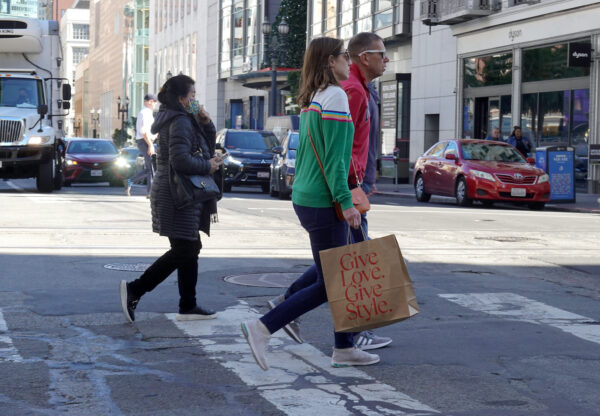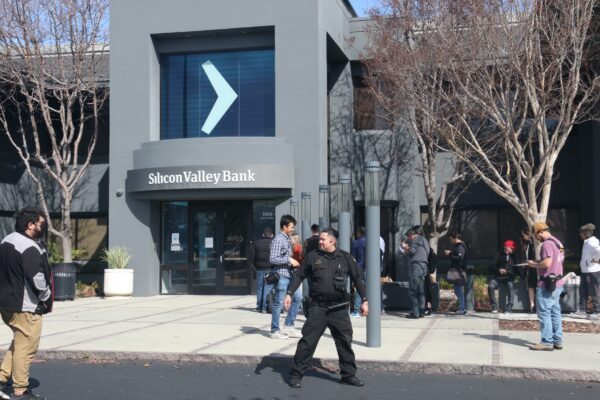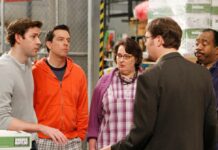The U.S. economy has made a remarkable comeback from COVID-19, growing by 2.1 percent in 2022 and returning to its pre-pandemic growth track.
Since President Joe Biden took office, the economy has recovered more than 12.5 million jobs and the unemployment rate has dropped to a 50-year low. The number of applications for new small businesses has also reached an all-time high, which Biden has frequently praised.
“The progress we’ve made creating strong, sustainable, economic growth has been real,” the president said on April 3 in a speech in Minnesota as part of his “Investing in America” tour.
Biden and his cabinet members have recently embarked on a tour of U.S. states to tell Americans that the administration’s economic agenda is working. Biden has spoken proudly of his legislative wins that helped unlock “more than $435 billion in private investment in less than two years.”
“I’ve never been more optimistic about the future of our country,” Biden said in Minnesota, highlighting his economic achievements over the past two years.
His optimism, however, is not helping to lift the nation’s mood. Surveys indicate that Americans are becoming increasingly pessimistic about the economy, although inflation has come down markedly since last summer.
Consumer prices rose by 6 percent annually in February, down from its 9.1 percent peak in June last year. But inflation is still uncomfortably high.
The consumer price index is up 15 percent since Biden took office in January 2021. Food prices are up 18 percent, energy costs have soared by 37 percent, and housing costs have increased by 13 percent during Biden’s presidency.
The Federal Reserve’s favorite inflation measure, the Personal Consumption Expenditures (PCE) price index, slowed in February to 5 percent annual rate, which was a welcome sign. Inflationary pressures, however, continue for the services sector.
“While PCE inflation data came in softer in February, the underlying details continued to be firmer,” Deutsche Bank warned in a recent report.
‘Weirdonomics’
JPMorgan economists characterize the current environment as “weirdonomics” due to the coexistence of numerous signs of strength and weakness in the economy.
“This uncertainty owes to the current mix of powerful drags and lifts, as well as the tension between tight labor markets and elevated inflation on the one hand, and healthy business sector balance sheets and growth-oriented policy biases on the other,” Bruce Kasman, chief economist and head of global economic research at JPMorgan Chase, wrote in a recent report.
Because of the unique characteristics of this environment, many economists are unable to make precise forecasts, which adds to the market anxiety.
A recent encouraging sign was the increase in consumer confidence despite the collapse of several U.S. banks. The consumer confidence index rose to 104.2 in March, bucking predictions for a decline. February confidence was also revised upward to 103.4.
The latest results, however, showed that consumer forecasts of inflation over the next 12 months remain stubbornly high at 6.3 percent.
Meanwhile, small business owners’ confidence in the economy declined in the first quarter of 2023 as inflation concerns persist, according to the MetLife and U.S. Chamber of Commerce Small Business Index.
Despite expecting economic headwinds in the coming months, more than 60 percent of small business owners say their business is in good health and they are content with their cash flow.
Many analysts are perplexed as to how business owners can be so confident in their own operations when there’s a widespread pessimism about the economy.
“There is a genuine confidence that if you can get through the pandemic, you can get through anything,” Tom Sullivan, vice president of small business policy at the U.S. Chamber of Commerce, told The Epoch Times.
But this is not blind optimism, Sullivan noted.
Small businesses are confident, but they are also savvy and attentive, ensuring that they are not over-leveraged as the economy deteriorates, he said.
Small Businesses See Weaker Economy
Growth has become increasingly difficult for business owners since tight credit conditions do not allow them to expand their operations or hire new employees.
Gary Lambert is the owner of Titan Storage, a storage facility in Spanish Fort, Alabama, providing different sized storage units for commercial and residential customers.
Lambert says his business has remained profitable despite high inflation and interest rates, but growth has now become nearly impossible.
“Self-storage is a cash intensive investment with stable returns. With skyrocketing material costs, interest rates, and labor prices, it has become more and more difficult to expand,” Lambert told The Epoch Times.
Marc Hardgrove, CEO of TheHoth, a digital marketing agency based in St. Petersburg, Florida, feels the same.
“As a digital marketing company, we have been focusing on retaining employees rather than hiring a new workforce,” he told The Epoch Times. “As the market is currently regressing, the IT sector has been fatally hit. In such a scenario, it is becoming increasingly important to manage the resources properly.”
‘Bottom Up, Middle Out’
During his three-week tour, the president and his cabinet members will be visiting more than 20 states to highlight the administration’s legislative victories, including the Inflation Reduction Act, the Bipartisan Infrastructure Law, and the CHIPs and Science Act, which together introduced $2 trillion in new government spending over the next 10 years.
More federal spending, according to Biden, encourages more private investment, which helps expand the economy “from the bottom up and the middle out.”

Advocates of “middle out” economics believe that national prosperity does not trickle down from wealthy individuals or companies. Instead, a thriving middle class is the primary driver of sustainable growth and prosperity.
The phrase “building the economy from the bottom up and middle out” has become a mantra of Biden’s presidency.
But the phrase is more than just a slogan, according to Nick Hanauer, an entrepreneur and venture capitalist who coined the phrase “middle out economics.”
In a recent op-ed in American Prospect, Hanauer argued that Biden’s embrace of the term reflects a paradigm shift in policymaking, but only few Americans understand its significance.
“Few Americans yet appreciate how significant this reversal in approach to economic policy will be, nor how big a positive difference these changes will make in their lives,” he wrote.
Biden’s economic messaging does not appear to be resonating with Americans, as his approval rating continues to fall.
In a recent poll conducted by The Associated Press-NORC Center for Public Affairs Research, the president’s approval rating dropped to 38 percent from 45 percent in February.
Biden’s handling of the nation’s economy has been a source of concern for many Americans since late 2021 because of stubbornly high inflation and ongoing recession fears.
Biden frequently cautions that Republican policies would undo the progress made by his administration. Polls, however, show that voters trust Republicans more than Democrats on the economy.
Recession Delayed?
Despite doomsday predictions and recession fears, the Biden administration has so far managed to postpone an economic collapse.
The reason the U.S. economy has not seen a full-blown recession is that government spending is massive, which has kept employment and economic activity strong, according to Daniel Lacalle, chief economist at hedge fund Tressis and an Epoch Times contributor.
“Massive deficit and debt have postponed the recession but worsened the inflation burden,” he said. “Recession is inevitable.”
Former Treasury Secretary Larry Summers has urged the Federal Reserve to continue raising interest rates in order to keep inflation under control.
“I certainly think the Fed needs to stay focused on the inflation challenge,” Summers told CNN on March 13. “And I think it’s what history teaches us: that if we don’t keep inflation controlled, we ultimately have much larger recessions and much more suffering.”
Summers comments came after banking crisis, when many urged the Fed to pause its rate hikes.
Keynesians and monetarists want to limit inflation by cutting demand, which is not the proper approach, according to economist Arthur Laffer, a former adviser to President Ronald Reagan.
“What we would like to see done for inflation is what we did in the early 1980s. We cut tax rates, we expanded output dramatically, and we restrained the quantity of money,” he explained in a recent interview with The Epoch Times. “Inflation came way down, and the economy boomed beyond imagination. That’s the supply-side approach to controlling inflation.”
“The way Larry Summers wants to do is to crush demand. And yes, he is right, we will have lower inflation. But we’ll get lower inflation with a lot lower output, employment, production, and a lot more despair and hardship. So you choose which model you’d prefer.”
Growing number of economists believe that if inflation does not return to the Fed’s comfort zone, more monetary tightening will be required, resulting in a hard landing in the economy.
Will Banking Crisis Lead to a Recession?
There’s a lot of uncertainty in the market right now, and many investors are wondering if the banking crisis caused by the recent failures of Silicon Valley Bank and Signature Bank has heightened the odds of an economic crash.

In response to the recent banking crisis, Biden stated that his administration had taken all possible measures to address the problem.
U.S. Chamber of Commerce applauded the Biden administration for acting swiftly to resolve the liquidity crisis at failed banks, which calmed the market.
“We’re seeing the opposite happen all over the world, where governments are not quick to make decisions and calm down the concerns,” Sullivan said.
Businesses with payrolls stuck in Silicon Valley Bank were able to access their funds as a result of this quick response, he added.
Laffer concurred, supporting the decision by regulators to guarantee all depositors following the collapse of SVB.
“That Sunday night, I think [Treasury Secretary] Janet Yellen was correct,” Laffer said. “Given that this thing was going to explode on Monday morning, if they didn’t guarantee the depositors, the run would be on, and there is no limit to how far that run goes.
“The only way to stop a run on the banks is to have a guarantee of depositors on the spot. And you can’t wait a week because it’s gone, it’s over in a week.”
Laffer contended that, unlike stock and bond holders, depositors should not be held personally accountable for a bank’s financial condition.
“How does General Motors diversify its exposures? I mean, they probably have 2 billion in deposits, maybe more,” he said.
The current data show no obvious negative reaction to the recent banking news. And in fact, some of the recent indicators have exceeded expectations.
However, banking analysts believe that the bank failures will eventually take their toll on the economy.
The Fed’s sharp interest rate increases have already slowed lending growth. And the banking crisis will cause “credit shocks,” exacerbating the situation, according to Morgan Stanley.
“Disruption in the financial system will leave its mark on the real economy,” Morgan Stanley economists wrote in a recent note. “Our banking analysts see permanently higher funding costs for banks going forward, and the disruption to funding markets will likely lead to a tightening in credit conditions beyond what’s embedded in our previous baseline for the economy.”
The Fed’s sharp interest rate increases have already slowed lending growth. And the banking crisis will make the situation far worse, according to Morgan Stanley.
“Our banking analysts see a meaningful increase in funding costs ahead, which will likely lead to tighter lending standards, slower loan growth, and wider loan spreads than previously expected,” the economists added in the note.
They also noted that tightening credit conditions this year would drag down the economic growth.
The manufacturing, commercial real estate, and technology sectors are the most vulnerable to pullback in bank lending, according to Goldman Sachs.
A reduction in lending will result in lower business investment in these industries, Jan Hatzius, chief economist of Goldman Sachs wrote in a recent note.
“We also expect slowing job growth in the leisure and hospitality and other services industries, as diminished loan availability dissuades restaurant operators and other smaller businesses from hiring new workers and opening new establishments.”
Commercial bank lending fell by $105 billion in the two weeks ending March 29—the largest since 1973. The sharp drop in lending was mainly caused by a decrease in real estate loans, as well as commercial and industrial loans.








